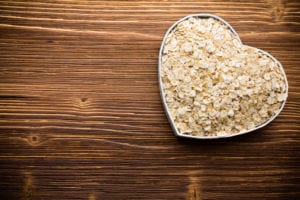Written by Chrystal Moulton, Staff Writer. A significantly lower incidence of death was found in participants in the highest dietary fiber intake group compared to the lowest for both all-cause mortality (HR = 0.84, P <0.001) and CVD mortality (our = 0.61, P <0.001).
 In a report on non-communicable diseases, cardiovascular disease (CVD) was cited as a leading cause of death 1. However, in most cases cardiovascular disease (CVD) is preventable and with proper diet can be ameliorated2,3. Furthermore, dietary fiber intake has been associated with a significantly reduced risk of CVD4-6. In the current trial, researchers investigated the association between dietary fiber intake and CVD mortality in Korean adults7.
In a report on non-communicable diseases, cardiovascular disease (CVD) was cited as a leading cause of death 1. However, in most cases cardiovascular disease (CVD) is preventable and with proper diet can be ameliorated2,3. Furthermore, dietary fiber intake has been associated with a significantly reduced risk of CVD4-6. In the current trial, researchers investigated the association between dietary fiber intake and CVD mortality in Korean adults7.
Researchers utilized data from the Korean genome and epidemiology study. These were a series of studies that took place over 12 years and is still ongoing. The study population included 211,571 adults (≥40yrs old) in urban and rural areas. Food frequency questionnaires were given to assess how often and how much of a particular food participants consumed in each meal in the past year. Participants were categorized into five groups based on dietary fiber intake ranging from low (Q1) to high (Q5). Anthropometric measurements along with blood pressure and fasting blood samples were taken for each participant. Blood glucose levels, HDL, LDL, total cholesterol, and triglycerides was measured for every sample. Questionnaires were also given to determine exercise habits, alcohol consumption, and smoking. All-cause mortality was the primary outcome of the trial. CVD mortality was the secondary outcome. Death of participants was tracked from the time they started the trial until 2019.
A total of 143,050 participants were selected for this study. At the end of the trial, 6421 deaths were reported. Of these, 5436 were classified as all-cause mortality and 985 classified as CVD mortality. The average age of participants was 53.9 ± 8.7 years old. About 64.4% of participants were women and 35.6% were men. Participants with the highest intake of dietary fiber had lower triglyceride (P = 0.022) and serum glucose levels (P < 0.001). These participants also had higher serum HDL- C levels (P= 0.001), higher BMI (P <0.001), consumed higher total energy and less carbohydrates, were more likely to exercise regularly (P <0.001) and live in urban areas (P <0.001). Low dietary fiber intake was significantly associated with higher cumulative death in all-cause mortality and CVD mortality (P <0.001). Individuals in the highest dietary fiber intake group also had the highest warranty period of life compared to lower quintiles in both all-cause and CVD mortality (all-cause mortality: 3.50 years /CVD mortality: 11.17 years). Hazard regression analysis also showed a significantly lower incidence of death in participants in the highest dietary fiber intake group compared to the lowest for both all-cause mortality (HR = 0.84, P<0.001) and CVD mortality (HR = 0.61, P <0.001) after adjusting for confounders. In participants with dyslipidemia, researchers found a significant inverse association between dietary fiber intake and both all-cause mortality (HR = 0.50, P < 0.05) and CVD mortality (HR = 0. 35, P < 0.05).
Through this study researchers confirmed that dietary fiber intake was significantly and inversely associated with CVD and all-cause mortality in Korean adults. Further research in other populations maybe needed to verify these findings.
Source: Kwon, Yu-Jin, Hye-Sun Lee, Goeun Park, Hyung-Mi Kim, and Ji-Won Lee. “Association of Dietary Fiber Intake with All-Cause Mortality and Cardiovascular Disease Mortality: A 10-Year Prospective Cohort Study.” Nutrients 14, no. 15 (2022): 3089.
© 2022 by the authors. Licensee MDPI, Basel, Switzerland. This article is an open access article distributed under the terms and conditions of the Creative Commons Attribution (CC BY) license (https:// creativecommons.org/licenses/by/ 4.0/).
Click here to read the full text study.
Posted October 10, 2022.
Chrystal Moulton BA, PMP, is a 2008 graduate of the University of Illinois at Chicago. She graduated with a bachelor’s in psychology with a focus on premedical studies and is a licensed project manager. She currently resides in Indianapolis, IN.
References:
- Global, regional, and national age-sex-specific mortality for 282 causes of death in 195 countries and territories, 1980-2017: a systematic analysis for the Global Burden of Disease Study 2017. Lancet. Nov 10 2018;392(10159):1736-1788. doi:10.1016/s0140-6736(18)32203-7
- Mensah GA, Wei GS, Sorlie PD, et al. Decline in Cardiovascular Mortality: Possible Causes and Implications. Circulation research. Jan 20 2017;120(2):366-380. doi:10.1161/circresaha.116.309115
- Cronin P, Joyce SA, O’Toole PW, O’Connor EM. Dietary Fibre Modulates the Gut Microbiota. Nutrients. May 13 2021;13(5)doi:10.3390/nu13051655
- Reynolds AN, Akerman AP, Mann J. Dietary fibre and whole grains in diabetes management: Systematic review and meta-analyses. PLoS Med. Mar 2020;17(3):e1003053. doi:10.1371/journal.pmed.1003053
- Threapleton DE, Greenwood DC, Evans CE, et al. Dietary fibre intake and risk of cardiovascular disease: systematic review and meta-analysis. Bmj. 2013;347:f6879.
- Kulezic A, Bergwall S, Fatemi S, et al. Healthy diet and fiber intake are associated with decreased risk of incident symptomatic peripheral artery disease – A prospective cohort study. Vascular medicine (London, England). Dec 2019;24(6):511-518. doi:10.1177/1358863×19867393
- Kwon YJ, Lee HS, Park GE, Lee JW. Association Between Dietary Fiber Intake and All-Cause and Cardiovascular Mortality in Middle Aged and Elderly Adults With Chronic Kidney Disease. Front Nutr. 2022;9:863391. doi:10.3389/fnut.2022.863391
